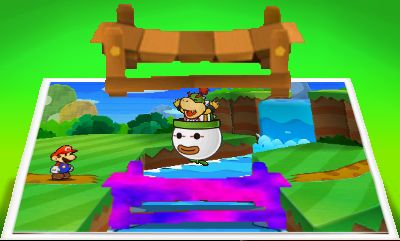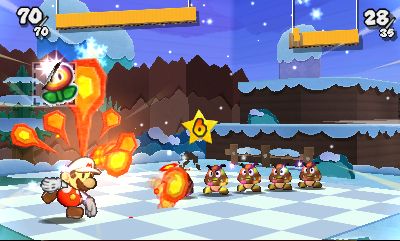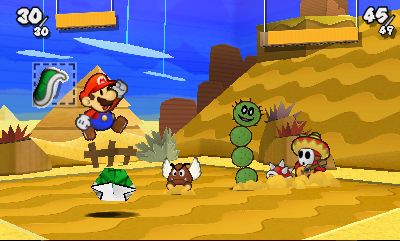Get this thing off me!
In the pantheon of Mario games, Super Mario RPG continues to stir great emotions in Mario fans. The plumber's first role-playing game had him face off with enemies in turn-based battles. While the collaboration with Squaresoft (now Square Enix) paid off in spades, Nintendo has taken it upon themselves to maintain Mario's RPG status with two separate spin-offs.
The first was Paper Mario on the Nintendo 64. Mario was flattened and ironed out and given the ability to explore a storybook world that reflected his new paper medium. The second was Mario & Luigi on Nintendo's handheld line. With the 3DS, Nintendo saw fit to let Paper Mario out of the house and into a wide world of buses, backseats, and even the bathroom with Sticker Star. Can a 2D hero keep up with the 3DS trademark visual effect or should Nintendo have crumpled this idea up and tossed it?
Paper Mario: Sticker Star introduces players to Kersti (stic-Ker) and the ability to use stickers on enemies and the world around Mario. The primary use of stickers is in combat. Jump stickers allow Mario to deal damage by pouncing on Goombas and Koopas, while Hammer stickers deal damage to enemies that would otherwise injure Mario's feet. Special stickers deal more damage or dole our special effects. You wouldn't want to stick a poison mushroom to yourself, would you?
Sticker Star, like every Paper Mario before it, also allows players to increase their damage (or decrease the enemy's) with properly timed button presses. Hitting the A button at the right moment can start a chain of jumps that can lead to your opponent's doom. When a Koopa shell flies at Mario, press the A button just before it hits to defend and halve the incoming damage.
What's more, players can pay coins to add bonuses to their turn. Spinning a slot machine of mushrooms, lightning bolts, and more can result in double or triple sticker turns, meaning the cadre of Goombas protected by that Shy-Guy will be no match for Mario. If you feel like you're unable to properly time your button presses, you can shell out more coins to guarantee two matches or a slower spinning wheel.
It's obvious that Nintendo intended for players to come up with interesting combos and overpowering feats of sticker strength, but it can feel like combat's boiled down to a pay-to-win scheme. You're always picking up coins from bonuses in combat or selling stickers at the shop, but eventually you'll discover it's best to grind up a huge bank only to spend it all on a challenging boss.

By the time you reach the world's big baddie, you might have thousands of coins saved up, but they're spent quickly as successive slot machine plays. In the end, it costs 90 coins to spin after repeated tries. It didn't need to be such a grind, but enemies dot every landscape you'll explore, making combat a routine you can't really run away from.
That said, it's worth it to defeat every enemy and gather every coin. Mario earns a bonus for wiping out his opponents in one fell swoop. Bosses on the other hand will take careful planning and management of stickers.
Even in the first world, a sticky-note stack of Goombas combine together into a formidable foe bent on collecting "shiny" stuff (some stickers are rarer than others, and thus more powerful). If Mario isn't careful, he might deplete his stock of attacks and powerups, leaving the Koopa troop to run wild. Matching all three images in the slot machine and throwing down three shiny Hammer stickers can feel incredibly empowering.
Additionally, Sticker Star is riddled with hilarious writing and visual gags. Longtime Mario fans and younger gamers will find a lot of dialogue to enjoy, with Kersti always at your side and a world full of Toads to rescue from cartoon doom. Nintendo's Treehouse localization services have always done an admirable job in the Paper Mario series, and that trend is continued here.

If you can avoid constant combat and do a little exploration, there's a ton of hidden secrets around the world, including a handful of special stickers and other goodies. Players would also do well to "stickerize" their world. Using Kersti, Mario can exit his current plane of reality to apply stickers to traps, objectives, and other environmental objects.
Hitting the Y button to stickerize an odd outcropping might reveal a hidden box that contains more stickers, coins, or even alternate paths. In this way, Paper Mario: Sticker Star begins to feel like a throwback to classic Mario games, complete with a healthy dose of tongue-in-cheek humor.
If you can get past the repetitive combat and possibly even enjoy the grind towards the final boss, there's a lot to love in Paper Mario: Sticker Star. It doesn't hold up against the compelling experiences Fall 2012 is rife with, but it's another worthy entry to the ever-expanding 3DS software library.
-
Rhythmic gameplay
-
Humor
-
Collecting and using strategic stickers
-
Creative bosses
-
Repetition
-
Pay to win







